Archivo de noviembre 2014
A Mayan Tradition: Hanal Pixan at Otoch Paal
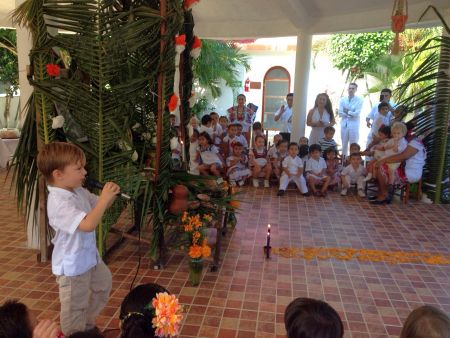 Mayan people remember their dead in a unique and original way. Each year, thousands of homes fill up with the scent of the “Cempasuchil” flower (Mexican
Mayan people remember their dead in a unique and original way. Each year, thousands of homes fill up with the scent of the “Cempasuchil” flower (Mexican  marigold), which they use to adorn the altars they lay out for their loved ones who have passed away. Mexicans think of death in a distinct way. They fear it and respect it, but they’re also able to laugh at it.
marigold), which they use to adorn the altars they lay out for their loved ones who have passed away. Mexicans think of death in a distinct way. They fear it and respect it, but they’re also able to laugh at it.
This view of death has prevailed for over 500 years; it started long before the Spanish brought Christianity to Mesoamerica. Both the Aztecs and the Mayans would have many rituals to help their dead on their journey to the underworld, the mythical world of the dead. Death was viewed only as a transitional stage in their universe.
Although the Spanish tried to convert the natives to Catholicism and institutionalized observance of the Day of the Faithful Departed, the natives found a way to continue their ancient traditions in disguise, and they transformed this Catholic tradition into what is known today as the celebration of the Day of the Dead. Meanwhile in the Yucatan Peninsula, the Mayans also honored their dead in slightly different celebration they called Hanal Pixan.
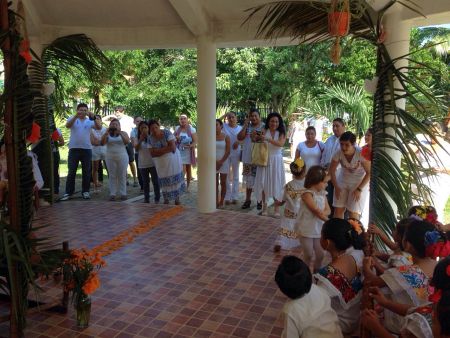 Hanal Pixan translates as “food for the souls”, and it does not only take place on one day, but it’s a celebration that lasts over a week. Most homes are adorned with an altar covered in offerings to welcome the souls of their dead relatives who come to see the living. It is believed that the dead come back to their home to be with their loved ones, to eat their favorite foods and to rest from the long journey, and eventually go back to their mythical resting place again.
Hanal Pixan translates as “food for the souls”, and it does not only take place on one day, but it’s a celebration that lasts over a week. Most homes are adorned with an altar covered in offerings to welcome the souls of their dead relatives who come to see the living. It is believed that the dead come back to their home to be with their loved ones, to eat their favorite foods and to rest from the long journey, and eventually go back to their mythical resting place again.
Every year, schools hold contests for the best altars. Students often learn about this important tradition by making their own altars at school to participate in the contest. It’s a good way to keep the tradition alive and teach the younger generations about it.
In the countryside, altars are set up the front porch or patio of many homes, or just about anywhere they can fit a table. They often add two more levels to form a three-story altar, covering it with a white table cloth, many times made especially for this occasion. The altar includes crosses, flowers, fruits, palm leaves, gourds with hard liquor, photos and memorabilia from the departed, among other elements.
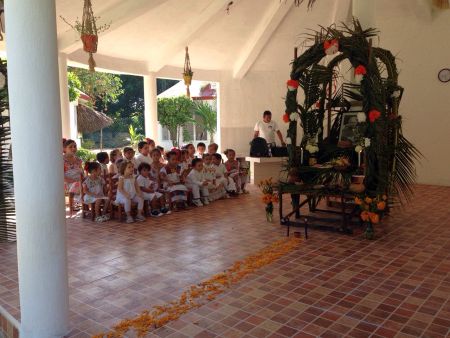 During the week of Hanal Pixan, there’s a day dedicated to honor the souls of children. Their altars include traditional candy, toys and colorful flowers that are believed to catch the children’s attention.
During the week of Hanal Pixan, there’s a day dedicated to honor the souls of children. Their altars include traditional candy, toys and colorful flowers that are believed to catch the children’s attention.
The offerings for adult souls are more serious, and they include different traditional dishes, such as pib or mucbilpollo (a large tamal cooked in a pit), chachac wajes (a tamal in red sauce), chacbinal (boiled corn), salbutes, atole (a hot, thick cornmeal drink), and other drinks that the departed used to like.
On the last day of this eight-day celebration, called Biix in Mayan language, they hold a mass in honor of the dead to wish them a safe trip back to their mythological resting place. They also light a path with candles on the front porch or patio to guide them on their way.
It’s impressive that these ancient traditions have managed to prevail to this day, in spite of world globalization and influences from foreign customs and celebrations, such as Halloween. Let’s not forget that the importance of Hanal Pixan and the Day of the Dead is to remember those who have passed away.
If you happen to come to the Yucatan during October or the first week of November, remember to ask people where you can see one of these altars so you can experience this special tradition first hand.
Hanal Pixan en Otoch Paal
Como es tradición, celebramos el Hanal Pixán en el Centro Comunitario Maya Otoch Paal
 La celebración del Hanal Pixán encuentra sus raíces en costumbres extendidas por los evangelizadores católicos (que a su vez se derivan de celebraciones celtas y de sus propias tradiciones teológicas) y ciertos rasgos mayas prehispánicos. Al correr los años, sus costumbres fueron sufriendo cambios con la llegada de los conquistadores y los misioneros, que adecuaron las antiguas tradiciones a las creencias religiosas y que son las que conservamos hasta nuestros días. Los orígenes de esta celebración se remontan al año 835 en que la iglesia cristiana designa el día 1 de noviembre como el día de los santos difuntos.
La celebración del Hanal Pixán encuentra sus raíces en costumbres extendidas por los evangelizadores católicos (que a su vez se derivan de celebraciones celtas y de sus propias tradiciones teológicas) y ciertos rasgos mayas prehispánicos. Al correr los años, sus costumbres fueron sufriendo cambios con la llegada de los conquistadores y los misioneros, que adecuaron las antiguas tradiciones a las creencias religiosas y que son las que conservamos hasta nuestros días. Los orígenes de esta celebración se remontan al año 835 en que la iglesia cristiana designa el día 1 de noviembre como el día de los santos difuntos.
Por un lado los mayas prehispánicos no tenían una fecha fija o establecida para celebrar o conmemorar a sus muertos en lo general. En consonancia a la costumbre de enterrar a sus muertos al interior de los basamentos de sus casas, o aprovechando oquedades como cavernas, cuevas e inclusos cenotes y en casos extraordinarios construyendo edificios exclusivos para conservar cadáveres de personas especiales, los mayas prehispánicos les rendían a diario algún tipo de ofrenda a sus antepasados muertos en espacios designados al interior de sus viviendas.  Fray Diego de Landa hace una breve pero rica descripción de la disposición de un altar dedicado a muertos evidenciando la importancia de la presencia del difunto mismo en ese espacio, por ejemplo utilizando una figura de barro en cuyo interior se depositaban las cenizas de un antepasado. No existía la idea del regreso de los muertos en ninguna fecha, al contrario, se sabe que existía todo un peregrinar entre los niveles del yaxché (o ceiba, árbol sagrado) para alcanzar su destino final, según sus actos.
Fray Diego de Landa hace una breve pero rica descripción de la disposición de un altar dedicado a muertos evidenciando la importancia de la presencia del difunto mismo en ese espacio, por ejemplo utilizando una figura de barro en cuyo interior se depositaban las cenizas de un antepasado. No existía la idea del regreso de los muertos en ninguna fecha, al contrario, se sabe que existía todo un peregrinar entre los niveles del yaxché (o ceiba, árbol sagrado) para alcanzar su destino final, según sus actos.
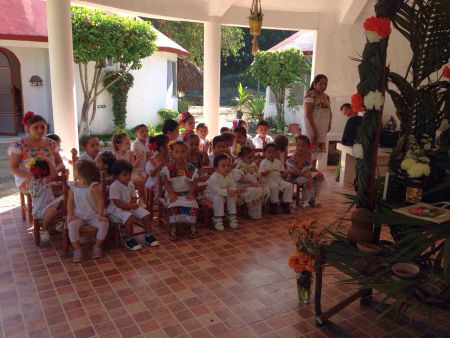 Los niños del Centro Comunitario, dedicaron el altar a María Montessori y explicaron la simbología de los elementos que pusieron para adornarlo.
Los niños del Centro Comunitario, dedicaron el altar a María Montessori y explicaron la simbología de los elementos que pusieron para adornarlo.

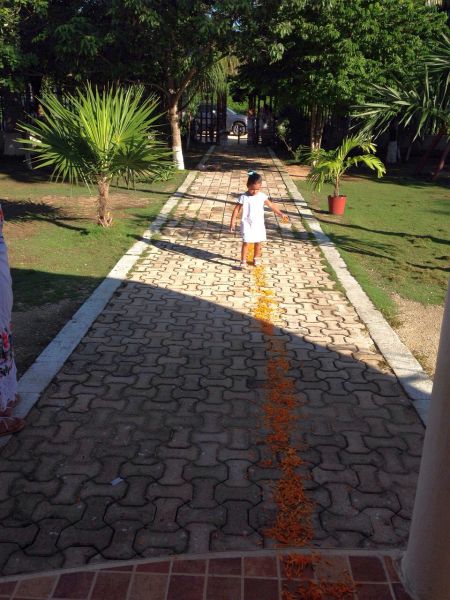
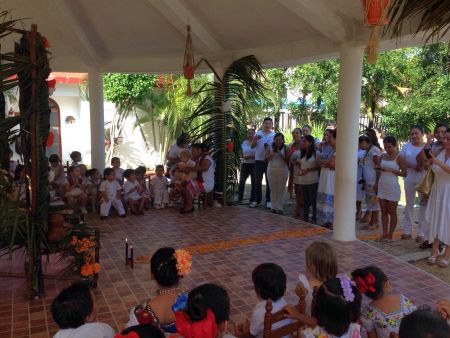
Comentarios recientes